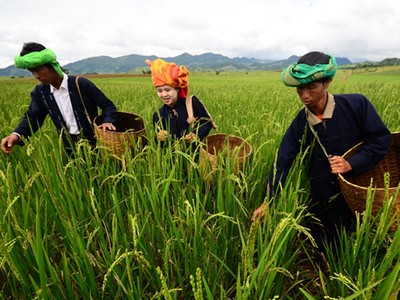Speeches Shim

OVERVIEW
U.S. assistance helps local enterprises to expand, creates new economic opportunities for local communities throughout the country, and empower smallholder farmers to improve their livelihoods.
Burma has enormous economic potential. It is a resource-rich country with access to large and growing markets. Nonetheless, a quarter of the country’s people live in poverty. The country seeks sustained economic transformation after decades of isolation, systemic corruption, and mismanagement. Many households cannot afford a nutritious diet and stunting among children is common. United States Government programs are working to meet those challenges by collaborating with the private sector, civil society, universities, and other donors to ensure equitable access to nutritious foods and inclusive economic opportunities for Burma’s people.
Enterprise-Driven Rural Economic Growth
While Burma’s rural economy has begun to transform, much remains to be done. Seventy percent of the population engage in agriculture for some or all of their income. USAID’s agriculture and food security investments help vulnerable ethnic and religious minority communities, increasing access to innovative technologies, finance, and private sector-driven extension services. USAID’s agriculture work also establishes commercial links between ethnic groups, recognizing that shared prosperity will contribute to a more peaceful future. USAID focuses on private sector engagement and a value chain approach to connect smallholder farmers to end markets. USAID combines efforts with other donors to reach the most vulnerable, particularly women, those vulnerable to trafficking, internally displaced people and people affected by conflict.
Giving People a Voice in Reforms
Political and economic reforms are deeply intertwined in Burma. The political reforms started, in part, from the realization that the country had fallen profoundly behind its neighbors in economic terms and that only people connected to the military were prospering. Economic factors underpin the various conflicts between Burma’s armed forces and ethnic groups. USAID’s economic assistance engages and cultivates reformers that are committed to advancing the core principles of inclusion, transparency, and accountability. USAID supports broad consultation on economic reforms and provides primary research and analysis in agriculture and nutrition to inform better policies. USAID programs bring people together for consultative economic rulemaking, strengthening U.S. national security by building new relationships among diverse communities in Myanmar and the world through market-based reforms.
Key Results for FY 2018-2019
- More than 220,000 rural households directly benefitted from US Feed the Future assistance.
- More than 70,000 farmers, a third of whom are women, benefitted from improved technology and management practices. 17 percent saw gross margins increase five-fold.
- USAID programs stimulated $61 million in agriculture exports and $3 million in new private sector investments.
- More than $28 million in non-collateralized loans have been made with USG assistance, benefitting 43,000 micro, small, and medium enterprises, including farmers.
- USAID-funded research informed the decision to lift restrictions on foreign companies purchasing local rice, pulses and maize for export in value-added form.
- USAID facilitated regulatory reform resulting in the licensing of the country’s first fully foreign-owned life insurance companies (including from the U.S.), generating a source of long-term capital savings for investments such as infrastructure projects and introducing competition into the non-transparent financial sector.
- USAID supported a regulatory change to improve availability of inputs and a market for outputs of microenterprises. Foreign firms, including American companies, may now freely conduct wholesale and retail distribution in many sectors.
- USAID helped Burma establish a Sanitary and Phytosanitary Enquiry Point in line with World Trade Organization requirements, making it easier for U.S. exporters and other traders to learn about Burma requirements.
- More than 100 enabling environment policies for private sector investment in agri-food systems are in process, from analysis to legislative approval to public consultations and implementation.
- USAID facilitated trade with Association of Southeast Asian Nations (ASEAN) members by assisting in the automation of a link to the ASEAN Single Window, a virtual portal that consolidates trade-related actions in one location to improve trade efficiency.
USAID is committed to supporting rural development to alleviate poverty and economic inequality. Transparent and inclusive economic development is critical to successful democratic transition in Burma.


Comment
Make a general inquiry or suggest an improvement.